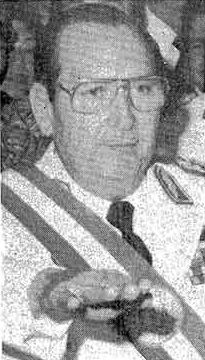Andrés Rodríguez (politician) facts for kids
Quick facts for kids
Andrés Rodríguez
|
|
|---|---|
 |
|
| 43rd President of Paraguay | |
| In office February 3, 1989 – August 15, 1993 Provisional: February 3, 1989 – May 15, 1989 |
|
| Preceded by | Alfredo Stroessner |
| Succeeded by | Juan Carlos Wasmosy |
| Personal details | |
| Born |
Andrés Rodríguez Pedotti
June 19, 1923 Borja, Departamento Guairá, Paraguay |
| Died | April 21, 1997 (aged 73) New York City, U.S. |
| Political party | Colorado Party |
| Military service | |
| Branch/service | Paraguayan Army |
| Years of service | 1946–1993 |
| Rank | Lieutenant General |
Andrés Rodríguez Pedotti (June 19, 1923 – April 21, 1997) was a Paraguayan military leader. He became the President of Paraguay on February 3, 1989. He took power after a military takeover against the long-time ruler, Alfredo Stroessner. Rodríguez served as president until August 15, 1993.
Taking Power in 1989
Andrés Rodríguez was a close friend and trusted officer of Alfredo Stroessner for many years. Their families were even connected through marriage. However, their relationship became difficult in the late 1980s.
Rodríguez started to connect with a group within the Colorado Party. This group wanted a more fair way of governing Paraguay. Things changed quickly in January 1989. Stroessner replaced some military leaders with people he trusted completely.
On February 2, Stroessner told Rodríguez he had to choose. He could either become the less important defense minister or leave the military. Rodríguez decided to act instead.
On the night of February 3, Rodríguez launched a military takeover. Soldiers and tanks surrounded the presidential headquarters in Asunción. The takeover had support from the Roman Catholic Church and the United States. The United States no longer needed Stroessner as an ally.
With this support, the takeover was successful very quickly. Stroessner resigned just hours after the fighting began. Many soldiers were lost during this event. Stroessner was later released and left the country. He found safety in Brazil.
A few weeks later, it was reported that Rodríguez had been planning this takeover since late 1988.
Becoming President
When Andrés Rodríguez became president, he made many surprising changes. He ended most of the strict rules that Stroessner had put in place. He stopped the death penalty and freed people who were held for political reasons. He also tried to hold some of Stroessner's former officials accountable.
Rodríguez officially ended the "state of siege" that had been in place for almost all of Stroessner's rule. This meant people had more freedom. He also welcomed back many Paraguayans who had been forced to leave the country.
In the week after the takeover, Rodríguez removed Stroessner's loyal officers from the military. He promoted new commanders to take their places.
As temporary president, Rodríguez dissolved the Congress on February 9. He then announced that new elections would be held in May. He also said that all political parties, except Communist ones, could take part. This was a big change for Paraguay. Before this, opposition parties were barely allowed to exist.
Rodríguez ran as the candidate for the Colorado Party. He won the election with 76 percent of the votes. This election was the fairest the country had seen in a long time.
After Stroessner was removed, representatives from the People's Republic of China contacted Rodríguez. They asked Paraguay to stop its diplomatic ties with Republic of China (Taiwan). However, Rodríguez decided to continue relations with Taiwan. This was because Taiwan offered development help and access to its markets, which was good for Paraguay.
End of His Time in Office and Death
On June 20, 1992, Paraguay adopted a new constitution. This new rule limited the president to only one five-year term. Presidents could not be re-elected. This rule applied to Rodríguez, even though he had already promised not to run again in 1993.
Rodríguez signed the new constitution into law on June 22. He stepped down as president on August 15, 1993. He was the first Paraguayan president in many decades to leave office peacefully at the end of his term. Juan Carlos Wasmosy, also from the Colorado Party, became the next president.
Andrés Rodríguez passed away in New York City in 1997. He had been battling cancer for a long time.
See also
 In Spanish: Andrés Rodríguez Pedotti para niños
In Spanish: Andrés Rodríguez Pedotti para niños

